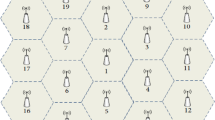Abstract
Energy efficiency is a significant requirement for the design and management of mobile networks and has recently gained substantial attention from both network operators and the research community. The general concept of energy saving management aims to match the capacity offered by operators to the actual demand at given times and geographic areas. This paper introduces the notion of energy partition, an association of powered-on and powered-off BSs to deliver network-level energy saving. It then elaborates how such concept is applied to perform energy re-configuration to flexibly re-act to load variations encouraging none or minimal extra energy consumption. A simulation-based study evaluates the performance of the proposed algorithms under different network topologies and traffic conditions, highlights the benefits and drawbacks, and provides recommendations for deployment scenarios.










Similar content being viewed by others
References
3GPP TR 32.826 (2009) Telecommunication management; Study on energy savings management (ESM), (rel 9)
Fettweis G, Zimmermann E (2008) ICT energy consumption—trends and challenges. In: 11th WPMC
Cisco visual networking index: global mobile data traffic forecast update, 2009–2014. White paper (2010)
3GPP TR 36.902 (2009) E-UTRAN; Self-configuration & self-optimizing network use cases & solutions, (Rel 9)
Marsan MA et al (2009) Optimal energy savings in cellular access networks. In: GreenComm workshop
Fehske AJ, Richter F, Fettweis GP (2009) Energy efficiency improvements through micro sites in cellular mobile radio networks. In: GreenComm2 workshop
Kim W-J et al (2009) Power efficient uplink resource allocation schemes in IEEE 802.16 OFDMA systems. IEICE Trans Commun E92-B(9):2891
Teyeb O, Van Phan V, Raaf B, Redana S (2009) Dynamic relaying in 3GPP LTE-advanced networks. In: EURASIP JWCN, vol 2009, article no 6
Izumikawa H et al (2010) Energy-efficient adaptive interface activation for delay/disruption tolerant networks. IEEE ICACT
Niu Z, Gong J, Yang Z (2010) Cell zooming for cost-efficient green cellular networks. IEEE Commun Mag 48(11):74–79
Zhou S et al (2009) Green mobile access network with dynamic base station energy saving. In: 15th ACM MobiCom
Schmelz LC et al (2009) Self-organisation in wireless networks use cases and their interrelation. In: 22nd WWRF
Dufkova K et al (2010) Energy savings for cellular network with evaluation of impact on data traffic performance. In: European wireless conference
Marsan MA, Meo, M (2009) Energy efficient management of two cellular access networks. In: ACM SIGCOMM GreenMetrics workshop
3GPP TS. 25.111 (2009) Technical Specification Group RAN; LMU performance specification; UE positioning in UTRAN, (Rel 9)
Necker MC (2008) Interference coordination in cellular OFDMA networks. IEEE Netw 22(6):12–19
Karakayali MK et al (2006) Network coordination for spectrally efficient communications in cellular systems. IEEE Wirel Commun 13(4):56–61
Amirijoo M, et al (2008) Neighbor cell relation list and physical cell identity self-organization in LTE. Comms. workshop
Bollobas B (2001) Random graphs, 2nd ed. Cambridge University Press, Cambridge, UK
Author information
Authors and Affiliations
Corresponding author
Rights and permissions
About this article
Cite this article
Samdanis, K., Taleb, T., Kutscher, D. et al. Self Organized Network Management Functions for Energy Efficient Cellular Urban Infrastructures. Mobile Netw Appl 17, 119–131 (2012). https://doi.org/10.1007/s11036-011-0293-7
Published:
Issue Date:
DOI: https://doi.org/10.1007/s11036-011-0293-7




